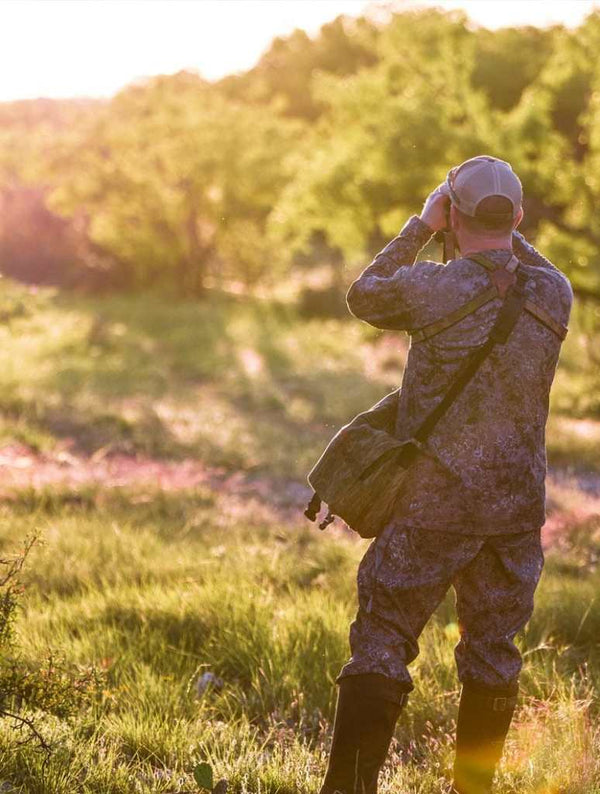WHEN TO CALL FOR WHITETAIL BUCKS
Sep 22, 2021
Weather
This article is about when to call for whitetail bucks, so why am I talking about the weather? Well, a phrase that has recently been coined by a very popular outdoor industry group answers the question pretty simply, “A whitetail’s movement ultimately revolves around the weather….” Deer research tells us the testosterone levels of whitetail bucks begin to elevate and their tendencies begin to shift towards hierarchy and breeding as soon as the velvet is shed from their antlers in late summer. This is true across all regions and subspecies. Velvet sheds in a month (maybe 2 months) window across the country. However, the rut can be found from August through February. Armed with that basic concept, let’s cover a few basic things about deer vocalization, how to look at them as a hunter, and how to plan for when to use them based on your hunting opportunities.

Time of Year
As we consider the idea of calling for bucks, it’s safe to say we are assuming some phase of rut behavior is occurring. As an old baseball rat, I’ll tell you that’s a good plan, because as any good baseball manager plays the odds over emotion, your best odds with any calling for whitetail deer is to play on the natural instincts of breeding and the competition created within the herd during this period. However, I feel we often times get too caught up in a sensationalized emotion where our imaginations are of bristled angry monster bucks grunting, growling, snorting, and challenging like Conor McGregor before his next UFC fight. That’s fun and is what great hunting films are made of, but deer are not prize fighters. They are a prey animal and survivors. Family groups and herd dynamics are crucial to how deer live, survive, and thrive.
Whitetail Deer Activity
So let’s start by being logical and playing the odds. Whitetail do get aggressive, but typically from the late summer shedding of velvet until actual breeding activities begin, progressive interaction to establish hierarchies in the herd unfold. Aggression happens in close personal outburst. It’s not the entire season and is most certainly not typical. Whitetail bucks aren’t running around throughout the fall talking smack and fighting.
I believe the best strategy is to focus your calling around the weather, highly active periods, and formulated around increased curiosity within the herd at optimal times. I’ve heard it explained this way….
If you were in your home, office, or anywhere of comfort you spend a lot of time and a stranger’s voice came upon you aggressive and booming, how would you respond? I’ll answer, it would scare you or at least startle you and put you on high alert. You would instantly go into the “Fight or Flight” natural response. In another scenario, if you were walking through your living room and you heard a social conversation taking place in the next room that was unsuspected but not startling, you’d almost certainly check it out.
Deer do not operate on ego, or humility for that matter. They are not burdened with that instinct as we humans are. Fight or Flight mentality is a 50/50 proposition for people. For deer it’s safe to assume it’s far more off balance. As a survivor, there is no ego and protective instinct. The response is FLIGHT every time. So when you call to a deer, especially blindly, take into account this and you can make some logical considerations about how to approach it. Attempt to fit in, be social, and subtly engage, but don’t’ be weird and out of place. Think like a deer and remember that if you startle a deer with your calling, the reaction will likely not be what you hoped for.

When to Call & How often to Call
When to call, how often to call, and what times to call are frequently asked questions. The responses vary across the board and every location is different. I personally believe this has more to do with herd density than anything else. If you walk into a private office with 2 or 3 people, likely you won’t hear much, even if there is ongoing communication. It’s subdued between small numbers of people. Inversely, during even the observing a “moment of silence” at a well attended sporting event, it’s almost never really silent. That many people and constant verbal communication is almost guaranteed. During a recent early season archery hunt in Oklahoma, I was privilege to spend 4 days on a private ranch with a very high density of deer. I was shocked at the number of deer vocalizations I heard from deer of all ages during the first week of October! I’m lucky to hear that much deer talk during best rut hunts of the year back home. It dawned on me quickly. The social interaction I was witnessing was easily contributed to that fact that I was surrounded by more deer than normal. Once congregated, the natural interaction between that many deer was inevitable. I can only imagine what it sounds like when breeding vocalization comes into play on that property! For the majority of hunters, don’t go into an average or low-density area where deer aren’t in large congregation and start yelling at everyone. Simply put, that will probably freak them out, just like the folks in the local insurance office would probably be a bit taken back if you walk into their lobby and started yelling like you did when you and your buddy were trying to communicate amongst a large group of friends at a party.

When to Call Aggressively
There are some occasions when aggressive calling could be the right call, but use it sparingly. If you can see and gauge the temperature of a whitetail buck during the rut and he is in your presence and hormonally driven to breed, you might coax him into a fight with aggressive calling techniques for dominance or coax him into falling in love with bleating and grunting techniques. However, I feel this should be done only at very certain times and with very certain purpose. It is high risk for majority of hunters and places they are hunting. It can ruin a hunt as fast as it makes one and your odds of blindly stumbling into such a scenario aren’t high! The better odds with a deer in your area unseen is social and curious interaction. Curiosity kills cats and bovines. Being invisible works WONDERS as well…. I’m just saying, play your odds.

The Bottom Line
It’s a hard picture to paint, but I think it comes with experience. When you see Whitetail deer respond and act naturally without your interaction, you begin to understand their communication better. Always remember you are trying to fit in. There is no product on the market that hypnotizes an animal into its own version of language and sucks them in. Deer are not birds nor human. Your best chances are to identify the deer herd you are hunting, how it’s established, and when it’s most vocal. Then attempt to subtly draw the curiosity of your mature deer in the heard by being social and being real. Deer don’t walk around bellowing like cattle and they don’t aggressively communicate with one another like a turkey. Use logic, play on the deer instincts to be social and then to breed in order to survive. And don’t let a call company ever convince you their sound is the end all be all that will trick them into acting in a way the we know is not instinctual for a whitetail deer. It’s a grunt. It’s not complicated audio!
Locke Wheeler



